
For more from IAM's impressive discography, stream away their tracks from here.
Stay tuned for the next podcast with guest Josquin as we discuss the third and final component of the French hip hop canon.
 The cover for IAM's single 'Planete Mars' In this latest podcast, special guest music afficionado Josquin breaks down the other most influential rap group in the French hip hop scene: IAM. In contrast with Paris suburbanites NTM, this talented team provides an alternative sound stemming from their south of France hometown Marseille. Instead of offering up hardcore gangsterism, IAM tells crafty tales of everyday life, combining slick production with Ancient Egypt mythology and outer space metaphors. For more from IAM's impressive discography, stream away their tracks from here. Stay tuned for the next podcast with guest Josquin as we discuss the third and final component of the French hip hop canon. Here's an IAM collaboration with Wu-Tang fam Sunz of Man. IAM's Ancient Egyptian and sci-fi themes blend perfectfly with Sunz of Man's Kung Fu predilections and 5 percenter mentality. Plus their music's almost the same!
0 Comments
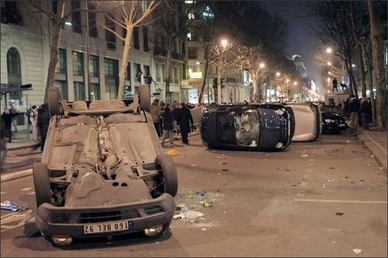 Cars overturned after anti-Israel protest in 2009 My friend Sara loathes Paris. Even a few hours in the City of Lights causes her great dismay and gets her red in the cheeks. She swears, that without fail, every visit to Paris she endures encounters with the most cantankerous people and the most insufferable inconveniences. Paris is out to get her. Perhaps this was regional bias coming from the Lille native, I thought. Like many other hip hop dancers from her hometown, she was just projecting a similar brand of East Coast vs. West Coast rap bitterness towards their rival city. But rather than call her out on it, I enabled. "Yeah people here can be pretty rude. They're not very friendly or open to people. Plus there's a lot of racism too." Oooh, the R-word. Sara responded, "Racism? Really? I don't think there is much." What?? Of course there's racism in Paris and in France as a whole, duhh. She must be blinded by her white girl privilege, thought the self-righteous American blogger. Her denial felt like a betrayal to her embrace of hip hop and to her rainbow coalition of friends. 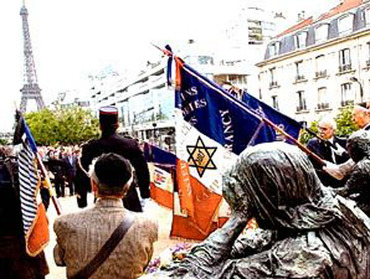 Protesters against France's acts of anti-Semitism during WWII I looked at Sara sitting across from me, decked out in Dickies khakis and a fresh purple tee like a Cali chola, her black Chuck Taylor's matching her geek chic thick-rimmed glasses. As she leaned forward on the table, her necklace swung around, dangling over her Big Mac. At the end of the chain, a small six-point star served as its pendulum. It was the Star of David. I realized that I wasn't seeing the whole picture. Race is an American preoccupation. In France, it's about a clash of cultures. It's about immigrants. It's about religion. What prejudice I see as racist at it's core, she may see as something else. France is home to not only Europe's largest Muslim population, but to its largest Jewish population as well. And the country has had a long, troubled history with its Jewish community. Guilt from the country's complicity in the Holocaust during the dark days of Nazi occupation still persist. In recent years, renewed anti-semitism has erupted as Israel-Palestine conflicts escalate. Anti-Israel protesters have sacked Jewish businesses in Paris. In the immigrant communities of the banlieues, Muslim and Jewish youth scuffle in the classroom and on the playground. French Jews have been the targets of violence including Ilan Halimi, a 23-year-old who was kidnapped, tortured, and killed. The assaults have led many French Jews to flee for Israel while others stay and seek resolutions from the Sarkozy government. The majority of France's 600,000 Jews come from waves of North African immigration since the 1950s. Many of these families immigrated to escape religious persecution in places like Morocco and Tunisia in the first place. They fear that history may be repeating itself.  Protest against desecration of Muslim and Jewish graves in 2008 I'm uncertain of Sara's family history. Maybe her parents came from Tunisia, escaping the riots of the 60s, after their ancestors settled there from Spain. Maybe her family came from Eastern Europe post-WWII looking for refuge. Maybe like the rapper Shyne, Sara just recently converted to Judaism.
In any case, I'm sure religion plays some role in her life and influences her worldview. But I doubt Sara would be caught up in the recent religious tensions, the line in the sand dividing neighbors. Her positive outlook and teethy smiles won't let her. It's because her sunny disposition is endangered by the rudeness of Parisians that she has such distaste for the city. She's looking to overcome the disputes and connect with people, not shut herself in. And so she continues to visit Paris nearly every other month. She comes for the hip hop events here. She comes for the people in these spaces. She comes for the community. Whether black, white, brown; Muslim, Christian, or Jewish; Sara has nothing but love to give. And judging by her popularity, that's also what she gets in return. In such a sheltered environment, it's no wonder that the "isms" don't really apply. 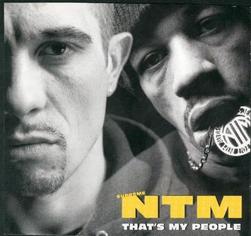 In this latest podcast, I chat with French music scenester Josquin about the realest of the real of French hip hop: Supreme NTM, the hardcore rap group that laid the foundation for France's rap scene. In contrast to the easy-listening stylings of MC Solaar, these boys pack the aggression like 9mm's tucked into the back of their sagging jeans. We cover the group's origins on the streets of Seine-Saint-Denis to their rise in the mid-90's to their mainstreamization. And of course, we listen to some choice tracks handpicked by Josquin.
For more of Paris' answer to NWA and Wu-Tang, check out this treasure trove of streaming tracks. Finally, something uniquely French. It's electro dance, a style of street dance born from the same country that gave the world Daft Punk. It obviously draws from vogueing, raving, wacking, and hip hop, but there's no doubt electro dance is in a world of it's own. And unlike its ancestors, it stresses routines in every round just as much as solos. Here's an inside look at a recent competition called Vertifight with insights from organizer Youval.  October's winners will represent France atthis main event in 2011 According to this blog, techtonik (but is it the same as electro dance?) originated mainly from the dance clubs in Southeast Paris, particularly Metropolis. But what's interesting is that in the context of Vertifight, all the dancers probably can't get into these clubs since they're still struggling with high school pre-calc. Youval mentioned that many youth took to electro dance via YouTube clips, which is probably also how Vertifight and the dance itself have successfully been exported all over the world (except the US).
Also interesting to note is that Youval considers electro dance the little brother of voguing. He can lay that claim as he is indeed one of the original and only voguers in Paris from the 1980's. But he maintains that his culture is none other than hip hop, as he's also from the first generation of b-boys and poppers. When he speaks about electro dance's misrepresentation in the mainstream media as "techtonik," I sense that he's linking it with the history of breakin' which outsiders termed "breakdancing" during its era of exploitation. But like breakin, electro dance has endured in the underground.  Somewhere between 5 Pointz in Queens and the tenements of the Broadway musical Rent lies Paris' own incubator for art: Les Frigos, literally "The Fridges." I ventured into Paris' 13th seeking a small art gallery for M-City's latest exhibition. I've read on blogs that the 13th is a hotbed for street art, but that didn't prepare me for what I discovered. Steps from the metro station, as I fumbled through my map, bold Krylon colors began seeping into my vision. I looked up and there before me was Les Frigos. "What is this?!" Jutting into the mid-day sky, amidst the clean steel and glass of the surrounding architecture, was a dilapidated castle, completely wrapped in art. Everything from wild style graffiti to Matisse-inspired nudes adorned its outer walls and surrounding fences. Add to that bass-heavy beats blast from its open windows, and all I could think of was "trashy Ivy League frat house?" If it wasn't already a condemned building, it was certainly shooting for that status. Though it seemed as though the building was off-limits, I made my way onto its grounds, and onto an open lot that perhaps once served as a moat. Massive graffiti pieces, throw-ups, and tags crawled up the castle's walls. And it wasn't some vestige of the past either. There were three writers there at that moment, spraying paint in the October wind.  Exterior of Les Frigos The trio comprised OFS graff crew. Three 20-something white guys, dressed in hoodies, drinking Heinekens, and getting their creative vandalism on. One of them wrote "JEN" with a very ornate, flowery style. I asked him if "JEN" was his girlfriend. "No, Jen is my name." Woops. "What does OFS mean?" "It means Oh Fucking Shit crew." "Oh." Jen told me that in Paris there are very few places to paint without getting harassed. This was one of them. No one ever gets arrested here. (Clearly, it was broad daylight and these guys sans disguises were painting away.) And though the groundskeeper occasionally threatens to call the police, he never does. 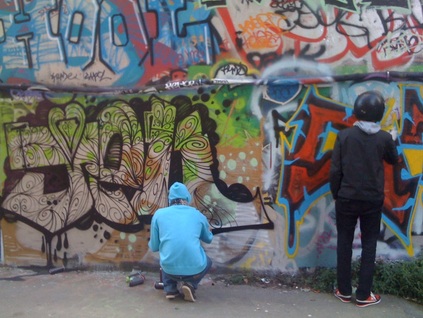 Jen gettin' busy. Why? I asked. Because the building is for squatters, mainly other artists, who obviously don't really mind. And unlike the permission-needed walls of 5 Pointz, which Jen sort of scoffed at, this environment was pretty much live and let live. So writers from all over Paris come to get up, go over other pieces, and maintain the authenticity of illegality. This attitude reflects the essence of Les Frigos. Once a 1920's cold storage facility for trains shipping produce, it has since been de-industrialized and taken to by artists and squatters for the past three decades. They eventually transformed the building and gave it new life by installing water, electricity, bathrooms, etc. It is now home to over a hundred rent-paying tenants and roughly 90 art studios. If you step inside, you're sure to find a labyrinth of floor-to-ceiling graffiti coupled with lively music. However, the future of Les Frigos remains uncertain. It's immediately clear that in the 13th, Les Frigos is the standalone holdout to the rehabilitation and dare I say gentrification of the neighborhood. It's located right in between the National Library of France and the University Denis-Diderot. Meanwhile, though this is a little unclear to me (damn Google translate!) the City of Paris has acquired the rights to the building. What that means for the occupancy agreements of the current tenants has yet to be seen. But until then, Jen and OFS will continue to decorate its walls, and so too will countless others. And for an art form that has always upheld ideas of transience and the finite-ness of things, the future may not really matter. So for now, Les Frigos may be in the cold, but it's still keeping art fresh. 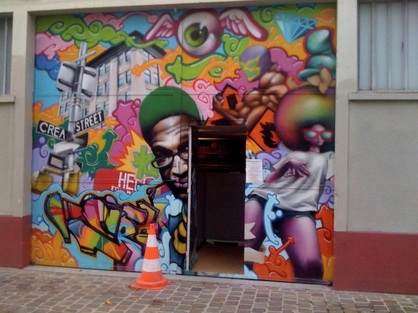 Entrance to Crea Street Delving deeper into the Paris graffiti world, in my latest podcast I interview Olivier Jacquet, graffiti artist, Graff It! magazine publisher, and owner of the street art store Crea Street. I was lucky to get the interview since I stumbled into his store on a random Saturday afternoon waiting for my ride at the Gentilly train station. Olivier was extremely friendly and gave great insight on where Paris graff writers get down, how they're cleverly evading the police, the different styles that come from various cities in France, and who's who in the Paris scene. A few other interesting things to note:
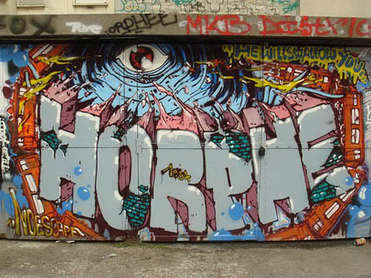
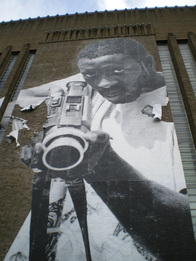 The 2011 TED prize for $100,000 has just been awarded to anonymous. TED has not revealed the award recipient's name, only a pair of letters--JR. They may be initials, they may be shorthand for "Junior," or they might mean something else completely different ("Jubilant Rhinos!"). One thing the letters do stand for, though, is thought-provoking street art. JR is a Paris-bred street artist, or as he prefers, photograffeur, a play on the words photographer and graffeur, the French word for graffiti artist. As his origin story goes, he started out writing graffiti until he happened upon a camera on the Paris Metro. He began photographing the youth of the banlieues and wheat-pasted their larger-than-life-size images all over the suburbs. Illegally, of course. Then he went global. In the past decade, he's postered urban slums all over the world with massive images of their local inhabitants. From favelas in Rio to rooftops in Kenya, he has gotten up. His goal: to draw attention to the humanity of everyday people in places that are far too often overlooked, impoverished, and plagued by conflict. As he says, "It's about breaking down barriers" through the image of the human face. "Everything is about eye contact." In 2006, returning to his native Paris one year after the country erupted in youth riots, JR snapped photos of the suburban youth from Montfermeil, Clichy-sous-Bois, and others. This time, instead of posting the young, brown faces in their own neighborhoods, he took their visages straight to the center of bourgeois Paris. The city ultimately embraced the work, "Portraits of a Generation," and in fact wrapped it's own city hall with these images, most likely in hopes of diffusing tensions and promoting tolerance. 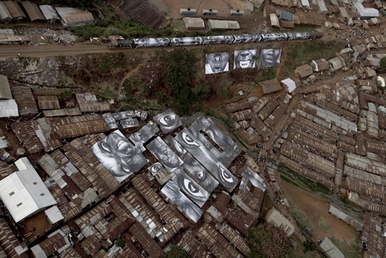 Shrouded in anonymity and myth, he maintains a Banksy-like persona of mystery, intelligence, and spectacle. But unlike the sardonic Brit, JR takes up social consciousness as his explicit agenda. He replaces humor with a sincerity to depict the lives of his subjects. And in fact, the local people he photographs also help him wallpaper their neighborhoods. Community engagement leads to community empowerment. TED lauds his work as "pervasive art" that engenders two important things: "The images are transported to London, New York, Berlin or Amsterdam where new people interpret them in the light of their own personal experience. And ongoing art and craft workshops in the originating community continue the work of celebrating everyone who lives there." [bold emphasis added by me] The TED prize committee hopes that JR's work could catalyze the entire TED community to support a philanthropic art project. Now with a hundred grand in hand, what will the photograffeur do next? Previous TED awardees, such as Bill Clinton, Bono, and writer Dave Eggers, have started various awareness campaigns. The most recent awardee, The Naked Chef Jamie Oliver has used the money to promote healthier eating habits in North America and the UK. Knowing JR who keeps the local community in mind, he will probably keep doing his thing but just go bigger. Who knows? Maybe this time next year satellite pictures of North Korea will have gigantic photographs of youthful eyes staring up at us. Here's a great video of his recent work displayed along the Seine in Paris. In this slide show, I take a look at the work of Paris street artist Speedy Graphito in his latest show at Art Partner Galerie. He comes from Paris' first generation of graffiti and street artists. In this exhibition, he draws on that long history, incorporating a number of street art styles and playing on the evolution of street art from its days as loathed youth vandalism to its current stature as darling of the art world. Like Bansky and Mr. Brainwash (whose work is appearing on the streets and stores of Paris right now), Speedy is cashing in but with a very knowing, self-aware wit. Here Speedy demonstrates his process as he prepares his painting "Dead or Alive." Speedy Graphito
"What Did You Expect?" Art Partner Galerie (Galerie Brugier-Rigail) 8, rue Sainte-Croix de la Bretonnerie 75004 Paris from now until 30 October, 2010  The three of us, cramped into the backseat of the VW Golf, suddenly got into a contest over who's visited the most countries. I boasted "8!" which soon ranked low on the impressive scale when Mar retorted with "12!" as he proceeded to list exactly which countries he's been to. But then both of us were dwarfed by Ich when he burst out with "16!" Counting with his fingers, he ran down the list of countries spanning most of Europe, North America, and Japan. Not bad, I thought. I wonder how many frequent flyer miles he has. It was an odd conversation to have amongst us three grown men. It's the kind of talk I'd expect to have on the school playground in first grade. "I have six GI Joes, how many do you have??" But when you speak almost no French and the French people with you speak a limited amount of English, you take what you can get. Unlike myself, Ich was genuinely excited to talk about all the countries he's visited, many of which had to do with international Hip Hop events. His eyes lit up even more though when he recounted the kind of food he's had in every place. But it's not that he speaks of bratwurst from Germany or fettucine from Italy. Instead he has the unique ability to rattle off the McDonald's menu and highlight its variations in every single country. "You have cheeseburger with shrimp in Japan!" And it doesn't end with McDonald's. He can also name every variety of Fanta and Schweppes according to the flavors available exclusively in a country. So when Ich goes to the Netherlands, he always makes it appoint to stock up on Fanta Cassis to take back to France, a Cassis-less land. He does the same with flavored bottled water and assorted candy.  Why does any of this matter? Well, allow me to paint the rest of the picture. During that 4-hour car ride, the only thing we listened to was the latest Lil Wayne mixtape and the new Nas & Damian Marley collabo album. Ich and Mar don't even understand a majority of what I say in English. How much can they really absorb of these rappers spitting fast rhymes riddled with local references and witty wordplay? Mar admitted that he looks up lyrics on the internet and just listens to the tracks over and over again till he gets it. In contrast to the ethnic pride apparel I mentioned in a previous post, Ich sat there decked out in his New Era cap, I heart NY hoodie, and Japanese anime t-shirt. Plus I can't forget his Dr. Dre Beats headphones saddled around his neck. Ich is black but yet goes by this Japanese name. It's short for Ichigo, the protagonist of his favorite anime Bleach. In fact everyone in his dance crew is named after a character from Bleach. He also has a second crew called Super Mario Bros. I really don't know what his real name is. Yes, hip hoppers do tend to take on aliases, but usually you hear someone refer to them by their birth name once in a while. Not the case for Ich. 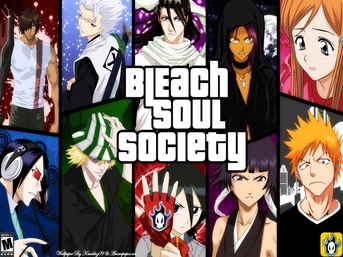 Ich's two favorite destinations out of the whopping 16 countries he's visited? New York City and Japan. He loves New York because quite simply it's the Mecca of Hip Hop. He loves Japan not only because of its incredible dance scene, but perhaps more so because of anime and manga. When I remarked how expensive Japan is, "C'est tre cher," (OK, I speak a tiny bit of French) he revealed that he saved 9,000 euros to spend one month there. It enabled him to live freely (ironically) and give in to his material desires. Indeed he must have purchased every single bit of Bleach paraphernalia. By the time the manga convention came around to Paris last September, Ich was so disappointed that he already had every product they were selling. Though I firmly believe in the power of Hip Hop, I question the repercussions when it's propped up firmly beside these other forms of global commodities and obsessive consumption. In part I came to Paris to get away from McDonald's and CocaCola and Target and all the crap I own. But I also came to connect with Hip Hop out here. Is it at all possible for me to engage one without the other? Later the following night, Ich was inhaling a McFlurry with a topping that was only available in Holland. "C'est la merde." I didn't quite follow. Was he saying that it was bad? "No," he said. "It's the shit."   Bear with me folks (or is it bare with me?), I'm trying something new with this entry. You might've noticed the nice little SoundCloud mp3 clip at the bottom of this entry. That's right folks, I'm breaking my new single! It's called "French Rapper's Delight." I kid, I kid. It's actually my first podcast. I'm very new at this medium so please consider, that from here, I can only go up. Today's topic of discussion: origins of the French Hip Hop scene and its brightest star MC Solaar. I realize that I forgot to mention that the intro music for the podcast, in case you didn't catch it, was MC Solaar's debut single "Bouge de la" which more or less means "Move on" or "Get out of here." For more on Solaar, check out his extensive bio on RFI Musique. Additionally, here's more background on the actions taken against French rappers following the 2005 riots.
|